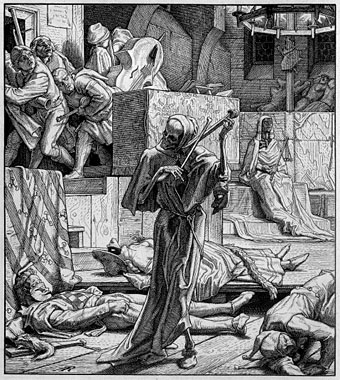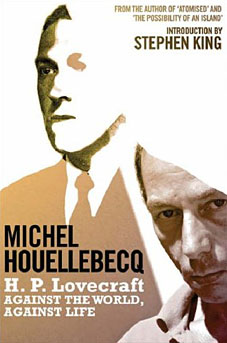Weird, but wonderful
| Harrison reviews Lovecraft.
Tag: Necronomicon
A playlist for Halloween

Der Tod als Erwürger (1851) by Alfred Rethel.
It’s a fact (sad or otherwise) that a substantial percentage of my music collection would make good Halloween listening but in that percentage a number of works are prominent as spooky favourites. So here’s another list to add to those already clogging the world’s servers, in no particular order:
Theme from Halloween (1978) by John Carpenter & Alan Howarth.
What a surprise… All John Carpenter‘s early films have electronic scores and great themes, Halloween being the most memorable, and one that’s gradually infected the wider musical culture as various hip hop borrowings and Heat Miser by Massive Attack demonstrate.
Monster Mash (1962) by Bobby “Boris” Pickett.
The ultimate Halloween novelty record. A host of imitators followed the success of this single while poor Bobby struggled to be more than a one-hit wonder. It wasn’t to be, this was his finest hour. Available on These Ghoulish Things: Horror Hits for Halloween with some radio spots by Bobby and a selection of other horror-themed rock’n’roll songs.
The Divine Punishment (1986) & Saint of the Pit (1988) by Diamanda Galás.
Parts 1 & 2 of Galás’s Masque of the Red Death, a “plague mass” trilogy based on the AIDS epidemic. These remain my favourite records by Ms Galás; on the first she reads/sings passages from the Old Testament accompanied by sinister keyboards, making the Bible sound as steeped in evil and metaphysical dread as the Necronomicon. On Saint of the Pit she turns her attention to French poets of the 19th century (Baudelaire, Gérard de Nerval & Tristan Corbière) while unleashing the full power of her operatic vocalizations. Einstürzende Neubauten’s FM Einheit adds some thundering drums. “Correct playback possible at maximum volume only.” Amen to that.
The Visitation (1969) by White Noise.
An electronic collage piece about a ghostly lover returning to his grieving girlfriend. White Noise were David Vorhaus working alongside BBC Radiophonic Workshop pioneers Delia Derbyshire and Brian Hodgson to create an early work of British electronica and dark psychedelia. The Visitation makes full use of Derbyshire and Hodgson’s inventive tape effects and probably accounts for them being asked to score The Legend of Hell House a few years later. Immediately following this is the drums and screams piece, Electric Storm In Hell; play this loud and watch the blood drain from the faces of your Halloween guests.
Zeit (1972) by Tangerine Dream.
Subtitled “A largo in four movements”, Zeit is Tangerine Dream’s most subtle and restrained album, four long tracks of droning atmospherics.
The Masque of the Red Death (1997) read by Gabriel Byrne.
From Closed On Account Of Rabies, a Poe-themed anthology arranged by Hal Willner. The readings are of variable quality; Christopher Walken’s The Raven is effective (although I prefer Willem Defoe’s amended version on Lou Reed’s The Raven) while Dr John reads Berenice like one of Poe’s somnambulists. Gabriel Byrne shows how these things should be done.
De Natura Sonoris no. 2 (1971) by Krzysztof Penderecki.
More familiar to people as “music from The Shining“, this piece, along with much of the Polish composer‘s early work, really does sound like music in search of a horror film. His cheerily-titled Threnody For The Victims Of Hiroshima is one piece that won’t be used to sell cars any time soon. Kubrick also used Penderecki’s equally chilling The Dream of Jacob for The Shining score, together with pieces by Ligeti and Bartók.
Treetop Drive (1994) by Deathprod.
Helge Sten is a Norwegian electronic experimentalist whose solo work is released under the Deathprod name. “Electronic” these days often means using laptops and the latest keyboard and sampling equipment. Deathprod music is created on old equipment which renders its provenance opaque leaving the listener to concentrate on the sounds rather than be troubled by how they might have been created. The noises on the deceptively-titled Treetop Drive are a disturbing series of slow loops with squalling chords, anguished shrieks and some massive foghorn rumble that seems to emanate from the depths of Davy Jones’ Locker. Play it in the dark and feel the world ending.
Ouroborindra (2005) by Eric Zann.
Another collection of sinister electronica from the Ghost Box label (see this earlier post), referencing HP Lovecraft and Arthur Machen’s masterpiece, The White People. Spectral presences haunting the margins of the radio spectrum.
Theme from The Addams Family (1964) by Vic Mizzy.
Never the Munsters, always the Addams Family! If you don’t know the difference, you must be dead.
Happy Halloween!
Previously on { feuilleton }
• The music of the Wicker Man
Down with human life
 Sam Leith is engrossed by a formidable essay on the father of ‘weird fiction’.
Sam Leith is engrossed by a formidable essay on the father of ‘weird fiction’.
HP Lovecraft: Against the World, Against Life
by Michel Houellebecq
tr by Dorna Kazheni
intro by Stephen King
256pp, Weidenfeld & Nicolson
£10 (pbk)
Saturday, August 12, 2006
The Daily Telegraph
“I AM SO BEASTLY TIRED of mankind and the world that nothing can interest me unless it contains a couple of murders on each page or deals with the horrors unnameable and unaccountable that leer down from the external universes.” So wrote Howard Phillips Lovecraft (1890–1937). His extraordinary body of work can be seen as a sustained effort to fill that prescription.
The founding father of what has become known as “weird fiction”, Lovecraft was not a congenial figure. Tall, ugly, misanthropic, snobbish, reclusive, he hated people in general, and people of other races in particular. More or less nothing happened in his life. He was 32 before he kissed a woman and his brief, unsuccessful and wholly unexpected marriage put paid to love for good. He died of intestinal cancer at 47.
His literary concerns were as follows: unkillable tentacled beings from beyond space worshipped by cannibal death cults; hideous prodigies of miscegenation; gibberings from the abyss; indecipherable languages of madness; insane architectural geometries; colours outside any nameable spectrum. Lovecraft has nothing in common with Anita Brookner.
On the surface, he has very little in common with Michel Houellebecq, either. What they seem to share, though, is an aggressive misanthropy. In this consistently engaging essay, an infatuated Houellebecq argues that Lovecraft’s work pioneered a sort of anti-literature: a great shout of “NO!” to human life.
Lovecraft was not just unrealistic, Houellebecq argues, but anti-realistic: the devotee of a sort of malevolent sublime. Religious writers see our animal lives as validated by the notion that beyond our perception lies something infinitely larger, more ancient and more benevolent. Lovecraft played with the opposite idea. If there’s something else, why should we imagine it would be benevolent? How much more likely that we have, here, a pretty disgusting animal existence; but that if we caught a whiff of what lies outside it, we’d go instantly mad—if we were lucky.
Very little of what Lovecraft wrote conforms to the conventional canons of what literature should be doing. His characters are more or less interchangeable: drab men with drab jobs, no pasts and no futures. They are there to bear witness, to have the living daylights frightened out of them and, if they are unlucky, to be “devoured by invisible monsters in broad daylight at the Damascus market square”. There’s no interest in human life, or money, or sex. The stories don’t start in the real world and amble into horror: they start midway through the screaming hab-dabs and turn up the volume from there producing what Houellebecq calls “an open slice of howling fear”. The involuted and clumsily baroque sentences disapproved of by Lovecraft’s detractors are serving, then, a singular purpose: to pile more on—to generate an intoxicating fever pitch of rhetoric.
Houellebecq’s essay is often perverse, sometimes jejune, more than occasionally downright silly. He attributes more consistency of philosophical purpose to Lovecraft than, I think, a sensible reading of the “great texts”—”The Call of Cthulhu” (1926), ‘The Colour Out of Space” (1927), ‘The Dunwich Horror” (1928), “The Whisperer in Darkness” (1930), “At the Mountains of Madness” (1931), “The Dreams in the Witch House” (1932), ‘The Shadow over Innsmouth” (1932) and “The Shadow Out of Time” (1934)—will bear.
And he on more than one occasion dismisses Lovecraft’s critics, with Houellebecquian arrogance, as “idiots” and such like. But his essay is both a formidable literary performance in itself, a work of real imaginative sympathy, and a consistently engrossing intellectual workout. It bursts with new ideas, and new ways of thinking about this oddest of writers. Bolstered by an introduction by Stephen King, and a pair of first-rate Lovecraft stories, it’s worth anyone’s tenner.
Lovecraft, as Houellebecq observes, “writes for an audience of fanatics—readers he was finally to find only years after his death”. That his work at last found those readers is beyond question. The “Cthulhu Mythos”, like Tolkien’s Middle-Earth, has become a place in which devotees live.
Ever since Lovecraft’s friend August Derleth completed some of his unfinished stories after his death, fantasy writers have done more than imitate Lovecraft’s approach: they have set their stories in his universe. The internet now throws up thousands of references to the mythos, allusions to the dread Necronomicon, and artists’ imaginings of Lovecraft’s monsters.
When I was a child, there was a Call of Cthuthu role-playing game. There’s even an internet cartoon series, “Hello Cthulhu“, that pits the Elder Gods against the overpowering cuteness of “Hello Kitty”. “Hi there! Would you like a cookie?!?” asks a fwuffy kitty with a ribbon in her hair. “No, actually. I would hate to have a cookie, you vapid waste of inedible flesh!” retorts Cthulhu. Lovecraft wouldn’t have liked it, I don’t think. But somewhere, sepulchrally, he might have been flattered.
Previously on { feuilleton }
• Le horreur cosmique
